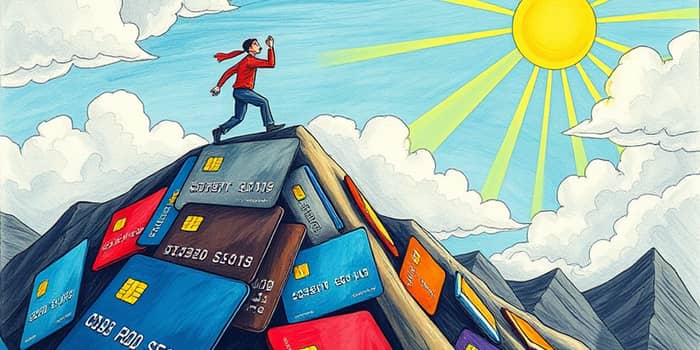
In early 2025, American households face $1.18 trillion nationwide burden as credit cards become a looming challenge for nearly half of all cardholders. With the average cardholder carrying an unpaid balance of $7,321, the cycle of minimum payments and mounting interest can feel overwhelming. Yet, practical strategies and thoughtful planning can pave a clear roadmap toward debt freedom. This article explores the scale of the problem, the emotional toll, and proven methods to regain financial control.
Credit card debt in the United States peaked at $1.21 trillion in late 2024 and has only slightly receded. Despite this marginal drop, balances remain 51% higher than they were in early 2021. Almost 48% of cardholders now carry month-to-month balances, up from 39% in 2021, and more than half have owed money for over a year. Delinquency rates, hovering around 3.05%, are near historic norms but signal persistent risk in a climate of persistently high monthly interest rates and economic uncertainty.
Beyond numbers on a statement, credit card debt affects mental health, relationships, and long-term aspirations. Stress from mounting bills can lead to sleepless nights and strained family dynamics. For younger generations, limited access to low-cost credit means fewer opportunities to build wealth, while middle-class families risk shrinking purchasing power. Acknowledging these pressures—both personal and systemic financial pressures and challenges—is the first step toward reclaiming peace of mind.
There is no one-size-fits-all method for tackling credit card debt. Each strategy balances psychological motivation, interest savings, and practical considerations. Whether you seek the momentum of small victories or the math-based advantage of interest reduction, awareness of your goals will guide your choice.
Selecting a repayment method depends on your individual financial profile, emotional resilience, and long-term objectives. Consider these factors:
Maintaining at least the minimum payments on all accounts prevents late fees and credit score damage. From there, redirect additional funds to your chosen strategy to drive long-term interest savings or to bolster momentum.
Consistently tracking progress and leveraging available resources can accelerate your journey. Whether you choose a debt management plan, negotiation with creditors for hardship assistance, or self-directed consolidation, these practices will keep you on course:
Embrace the psychological aspect by celebrating milestones—such as eliminating your first card—so you maintain enthusiasm and momentum. Remember that discipline and patience often outweigh speed.
The path to debt freedom can be long and occasionally demoralizing. You may face unexpected expenses or temptations to dip back into credit. Building an emergency fund, even modest, can shield you from setbacks. Engage a support network—friends, family, or online communities—to share victories and setbacks. Viewing this process as an investment in your future, rather than a temporary sacrifice, reframes challenges as steps toward a more secure life.
Credit card debt, while daunting, is a conquerable mountain. By understanding the dynamics behind the numbers and choosing a method aligned with your personality and goals, you move from feeling trapped to empowered. Each payment brings you closer to relief, and each strategy offers a path to quick win psychological momentum or optimized interest savings. The climb may be steep, but with consistency, planning, and perseverance, you will reach the summit and enjoy the freedom that comes from financial control.
References













